Radiocarbon Dating
- 格式:pdf
- 大小:225.53 KB
- 文档页数:4
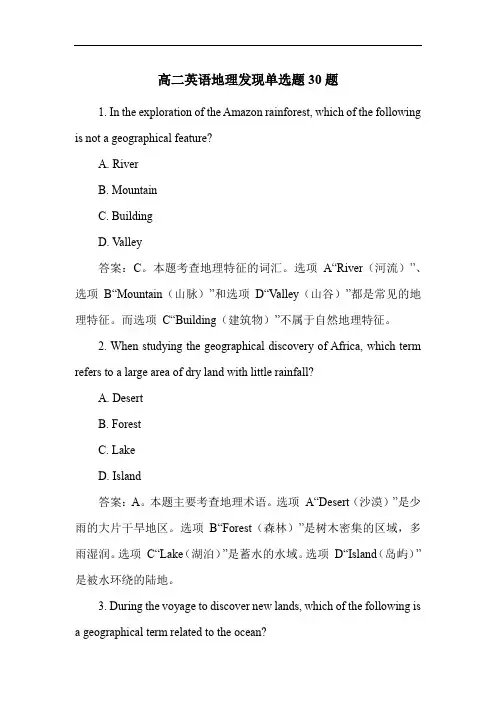
高二英语地理发现单选题30题1. In the exploration of the Amazon rainforest, which of the following is not a geographical feature?A. RiverB. MountainC. BuildingD. Valley答案:C。
本题考查地理特征的词汇。
选项A“River(河流)”、选项B“Mountain(山脉)”和选项D“Valley(山谷)”都是常见的地理特征。
而选项C“Building(建筑物)”不属于自然地理特征。
2. When studying the geographical discovery of Africa, which term refers to a large area of dry land with little rainfall?A. DesertB. ForestC. LakeD. Island答案:A。
本题主要考查地理术语。
选项A“Desert((沙漠)”是少雨的大片干旱地区。
选项B“Forest(森林)”是树木密集的区域,多雨湿润。
选项C“Lake((湖泊)”是蓄水的水域。
选项D“Island((岛屿)”是被水环绕的陆地。
3. During the voyage to discover new lands, which of the following isa geographical term related to the ocean?B. CanyonC. StraitD. Plain答案:C。
此题聚焦于海洋相关的地理术语。
选项A“Beach((海滩)”是海陆交界的部分。
选项B“Canyon(峡谷)”通常在陆地上。
选项C“Strait((海峡)”是连接两个海洋的狭窄水道,与海洋地理相关。
选项D“Plain(平原)”是陆地地形。
4. In the study of geographical discoveries, which of the following is not a geographical term for a landform?A. PlateauB. PeninsulaC. GlacierD. Market答案:D。
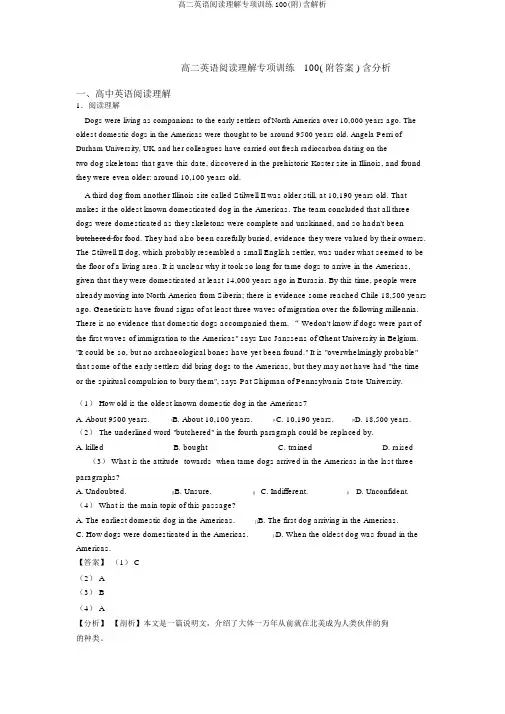
高二英语阅读理解专项训练100(附)含解析高二英语阅读理解专项训练100( 附答案 ) 含分析一、高中英语阅读理解1.阅读理解Dogs were living as companions to the early settlers of North America over 10,000 years ago. The oldest domestic dogs in the Americas were thought to be around 9500 years old. Angela Perri of Durham University, UK, and her colleagues have carried out fresh radiocarbon dating on thetwo dog skeletons that gave this date, discovered in the prehistoric Koster site in Illinois, and found they were even older: around 10,100 years old.A third dog from another Illinois site called Stilwell II was older still, at 10,190 years old. That makes it the oldest known domesticated dog in the Americas. The team concluded that all three dogs were domesticated as they skeletons were complete and unskinned, and so hadn't been butchered for food. They had also been carefully buried, evidence they were valued by their owners. The Stilwell II dog, which probably resembled a small English settler, was under what seemed to be the floor of a living area. It is unclear why it took so long for tame dogs to arrive in the Americas, given that they were domesticated at least 14,000 years ago in Eurasia. By this time, people were already moving into North America from Siberia; there is evidence some reached Chile 18,500 years ago. Geneticists have found signs of at least three waves of migration over the following millennia. There is no evidence that domestic dogs accompanied them. “ Wedon't know if dogs were part of the first waves of immigration to the Americas" says Luc Janssens of Ghent University in Belgium. "It could be so, but no archaeological bones have yet been found." It is "overwhelmingly probable" that some of the early settlers did bring dogs to the Americas, but they may not have had "the time or the spiritual compulsion to bury them", says Pat Shipman of Pennsylvania State University.(1) How old is the oldest known domestic dog in the Americas7A. About 9500 years.B. About 10,100 years.C. 10,190 years.D. 18,500 years.(2) The underlined word "butchered" in the fourth paragraph could be replaced by.A. killedB. boughtC. trainedD. raised(3) What is the attitude towards when tame dogs arrived in the Americas in the last three paragraphs?A. Undoubted.B. Unsure.(4) What is the main topic of this passage? A. The earliest domestic dog in the Americas. C. How dogs were domesticated in the Americas. Americas.【答案】(1) C(2) A(3) B(4) AC. Indifferent.D. Unconfident.B. The first dog arriving in the Americas.D. When the oldest dog was found in the【分析】【剖析】本文是一篇说明文,介绍了大体一万年从前就在北美成为人类伙伴的狗的种类。
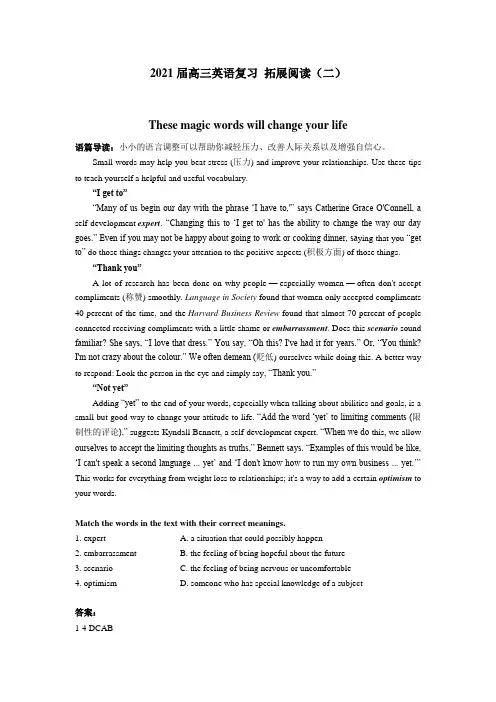
2021届高三英语复习拓展阅读(二)These magic words will change your life语篇导读:小小的语言调整可以帮助你减轻压力、改善人际关系以及增强自信心。
Small words may help you beat stress (压力) and improve your relationships. Use these tips to teach yourself a helpful and useful vocabulary.“I get to”“Many of us begin our day with the phrase ‘I have to,'” says Catherine Grace O'Connell, a self-development expert. “Changing this to ‘I get to' has the ability to change the way our day goes.” Even if you may not be happy about going to work or cooking dinner, sa ying that you “get to” do those things changes your attention to the positive aspects (积极方面) of those things.“Thank you”A lot of research has been done on why people — especially women — often don't accept compliments (称赞) smoothly. Language in Society found that women only accepted compliments 40 percent of the time, and the Harvard Business Review found that almost 70 percent of people connected receiving compliments with a little shame or embarrassment. Does this scenario sound familiar? She says, “I love that dress.” You say, “Oh this? I've had it for years.” Or, “You think? I'm not crazy about the colour.” We often demean (贬低) ourselves while doing this. A better way to respond: Look the person in the eye and simply say, “Thank you.”“Not yet”Adding “yet” to the end of your words, especially when talking about abilities and goals, is a small but good way to change your attitude to life. “Add the word‘yet’ to limiting comments (限制性的评论),” suggests Kyndall Bennett, a self-development expert. “When we do this, we allow ourselves to accept the limiting thoughts as truths,” Bennett says. “Examples of this would be like, ‘I can't speak a second language ... yet’ and ‘I don't know how to run my own business ... yet.’” This works for everything from weight loss to relationships; it's a way to add a certain optimism to your words.Match the words in the text with their correct meanings.1. expert A. a situation that could possibly happen2. embarrassment B. the feeling of being hopeful about the future3. scenario C. the feeling of being nervous or uncomfortable4. optimism D. someone who has special knowledge of a subject答案:1-4 DCABA weekend in Belgium语篇阅读:作者描述了自己去比利时旅游的经历。
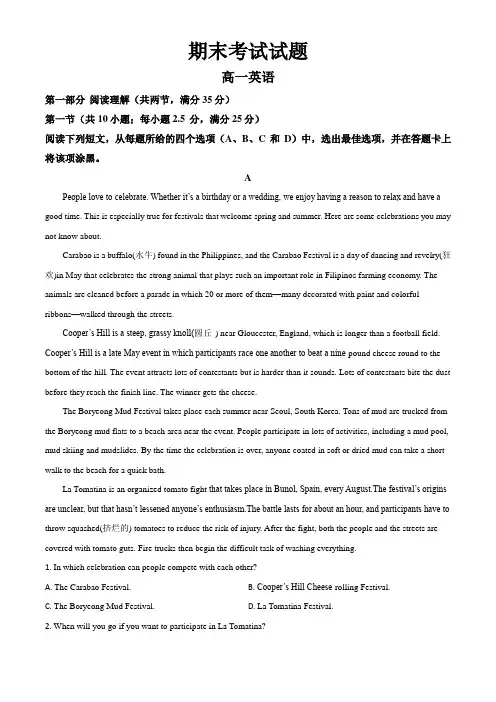
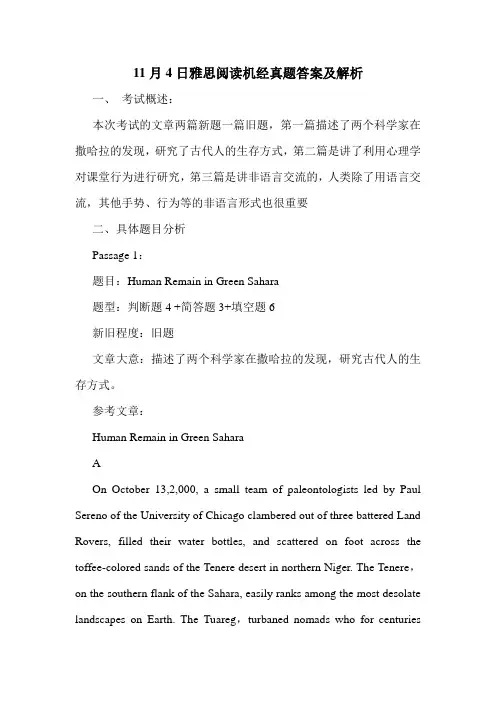
11月4日雅思阅读机经真题答案及解析一、考试概述:本次考试的文章两篇新题一篇旧题,第一篇描述了两个科学家在撒哈拉的发现,研究了古代人的生存方式,第二篇是讲了利用心理学对课堂行为进行研究,第三篇是讲非语言交流的,人类除了用语言交流,其他手势、行为等的非语言形式也很重要二、具体题目分析Passage 1:题目:Human Remain in Green Sahara题型:判断题4 +简答题3+填空题6新旧程度:旧题文章大意:描述了两个科学家在撒哈拉的发现,研究古代人的生存方式。
参考文章:Human Remain in Green SaharaAOn October 13,2,000, a small team of paleontologists led by Paul Sereno of the University of Chicago clambered out of three battered Land Rovers, filled their water bottles, and scattered on foot across the toffee-colored sands of the Tenere desert in northern Niger. The Tenere,on the southern flank of the Sahara, easily ranks among the most desolate landscapes on Earth. The Tuareg,turbaned nomads who for centurieshave ruled this barren realm, refer to it as a “desert within a desert”a California-size ocean of sand and rock, where a single massive dune might stretch a hundred miles, and the combination of 120-degreeheat and inexorable winds can wick the water from a human body in less than a day. The harsh conditions, combined with intermittent conflict between the Tuareg and the Niger government, have kept the region largely unexplored.BMike Hettwer, a photographer accompanying the team, headed off by himself toward a trio of small dunes. He crested the first slope and stared in amazement. The dunes were spilling over with bones. He took a few shots with his digital camera and hurried back to the Land Rovers. ‘I found some bones:’Hettwer said, when the team had regrouped. “But they’re not dinosaurs. They’re human.”CIn the spring of 2005 Sereno contacted Elena Garcea, an archaeologist at the University of Cassino, in Italy, inviting her to accompany him on a return to the site. Garcea had spent three decades working digs along the Nile in Sudan and in the mountains of the Libyan Desert, and was well acquainted with the ancient peoples of the Sahara. But she had never heard of Paul Sereno. His claim to have found so many skeletons in one place seemed far fetched, given that no other Neolithic cemeterycontained more than a dozen or so. Some archaeologists would later be skeptical; one sniped that he was just a ‘moonlighting paleontologist.’But Garcea was too intrigued to dismiss him as an interloper. She agreed to join him.DGarcea explained that the Kiffian were a fishing-based culture and lived during the earliest wet period, between 8,000 and 10,000 years ago. She held a Kiffian sherd next to a Tenerian one. “What is so amazing is that the people who made these two pots lived more than a thousand years apart.EOver the next three weeks, Sereno and Garcea-- along with five American excavators, five Tuareg guides, and five soldiers from Niger’s army, sent to protect the camp from bandits-- made a detailed map of the site, which they dubbed Gobero, after the Tuareg name for the area. They exhumed eight burials and collected scores of artifacts from both cultures. In a dry lake bed adjacent to the dunes, they found dozens of fishhooks and harpoons carved from animal bone. Apparently the Kiffian fishermen weren’t just going after small fry: Scattered near the dunes were the remains of Nile perch, a beast of a fish that can weigh nearly 300 pounds, as well as crocodile and hippo bones.FSereno flew home with the most important skeletons and artifacts and immediately began planning for the next field season. In the meantime, he carefully removed one tooth from each of four skulls and sent them to a lab for radiocarbon dating. The results pegged the age of the tightly bundled burial sat roughly 9,000 years old, the heart of the Kiffian era. The smaller ‘sleeping’skeletons turned out to be about 6,000 years old, well within the Tenerian period. At least now the scientists knew who was who.G In the fall of 2006 they returned to Gobero, accompanied by a larger dig crew and six additional scientists. Garcea hoped to excavate some80 burials, and the team began digging. As the skeletons began to emerge from the dunes, each presented a fresh riddle, especially the Tenerian. A male skeleton had been buried with a finger in his mouth.HEven at the site, Arizona State University bioarchaeologist Chris Stojanowski could begin to piece together some clues. Judging by the bones, the Kiffian appeared t o be a peaceful, hardworking people. “The lack of head and forearm injuries suggests they weren’t doing much fighting,” he told me. “And these guys were strong.” He pointed to a long,narrow ridge running along a femur. “That’s the muscle attachment,” he said. “This individual had huge leg muscles, which means he was eating a lot of protein and had a strenuous lifestyle-- bothconsistent with a fishing way of life.” For contrast, he showed me the femur of a Tenerian male. The ridge was barely perceptible. “T his guy had a much less strenuous lifestyle,” he said, “which you might expect of a herder.”IStojanowski’s assessment that the Tenerian were herders fits the prevailing view among scholars of life in the Sahara 6,000 years ago, when drier conditions favored herding over hunting. But if the Tenerian were herders, Sereno pointed out, where were the herds? Among the hundreds of animal bones that had turned up at the site, none belonged to goats or sheep, and only three came from a cow species. “It’s not unusual for a herding culture not to slaughter their cattle, particularly in a cemetery,M Garcea responded, noting that even modem pastoralists, such as Niger’s Wodaabe, are loath to butcher even one animal in their herd. Perhaps, Sereno reasoned, the Tenerian at Gobero were a transitional group that had not fully adopted herding and still relied heavily on hunting and fishing.JBack in Arizona, Stojanowski continues to analyze the Gobero bones for clues to the Green Saharans’health and diet. Other scientists are trying to derive DNA from the teeth, which could reveal the genetic origins of the Kiffian and Tenerian —and possibly link them todescendants living today. Sereno and Garcea estimate a hundred burials remain to be excavated. But as the harsh Tenere winds continue to erode the dunes, time is running out. “Every archaeological site has a life cycle,” Garcea said. “It begins when people begin to use the place, followed by disuse, then nature takes over, and finally it is gone. Gobero is at the end of its life.”。
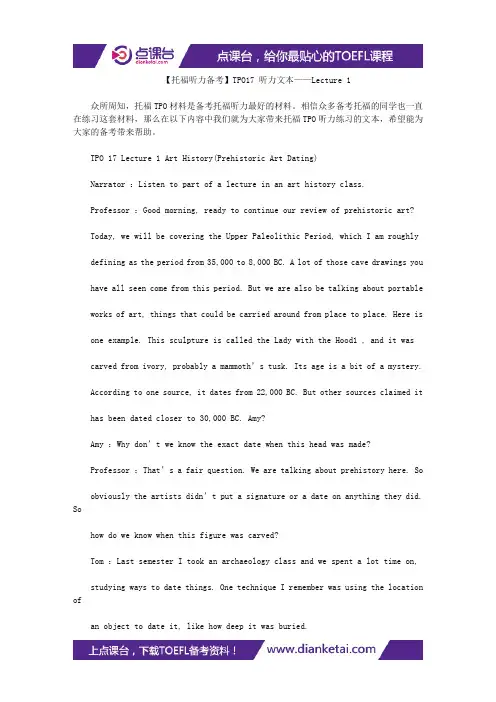
【托福听力备考】TPO17 听力文本——Lecture 1众所周知,托福TPO材料是备考托福听力最好的材料。
相信众多备考托福的同学也一直在练习这套材料,那么在以下内容中我们就为大家带来托福TPO听力练习的文本,希望能为大家的备考带来帮助。
TPO 17 Lecture 1 Art History(Prehistoric Art Dating)Narrator :Listen to part of a lecture in an art history class.Professor :Good morning, ready to continue our review of prehistoric art?Today, we will be covering the Upper Paleolithic Period, which I am roughlydefining as the period from 35,000 to 8,000 BC. A lot of those cave drawings youhave all seen come from this period. But we are also be talking about portableworks of art, things that could be carried around from place to place. Here isone example. This sculpture is called the Lady with the Hood1 , and it wascarved from ivory, probably a mammoth’s tusk. Its age is a bit of a mystery.According to one source, it dates from 22,000 BC. But other sources claimed ithas been dated closer to 30,000 BC. Amy?Amy :Why don’t we know the exact date when this head was made?Professor :That’s a fair question. We are talking about prehistory here. Soobviously the artists didn’t put a signature or a date on anything they did. Sohow do we know when this figure was carved?Tom :Last semester I took an archaeology class and we spent a lot time on,studying ways to date things. One technique I remember was using the location ofan object to date it, like how deep it was buried.Professor :That would be Stratigraphy. Stratigraphy is used for dating portable art. When archaeologists are digging at a site, they make very careful notes about which stratum(strata), which layer of earth they find things in. And, you know, the general rule is that the oldest layers are at the lowest level. But this only works if the site hasn’t been touched, and the layers are intact. A problem with this dating method is that an object could have been carried around, used for several generations before it was discarded. So it might be much older than the layer or even the site where it was found. The stratification technique gives us the minimum age of an object, which isn’t necessarilly its true age. Tom, in your archaeology class, did you talk about radiocarbon dating?Tom :Yeah, we did. That had to do with chemical analysis, something to do with measuring the amount of radiocarbon that’s left in organic stuff. Because we know how fast radiocarbon decays, we can figure out the age of the organic material.Professor :The key word there is organic. Is art made of organicmaterial?Tom :Well, you said the lady with the hood was carved out of ivory. That ’s organic.Professor :Absolutely. Any other examples?Amy :Well, when they did those cave drawings. Didn’t they use, like chacoalor maybe colors, dyes made from plants?Professor :Fortunately, they did, at least some of the time. So it turns outthat radiocarbon dating works for a lot of prehistoric art. But again there’s aproblem. This technique destroys what it analyzes, so you have to chip off bits of the object for testing. Obviously we are reluctant to do that in some cases.And apart from that, there’s another problems. The date tells you the age of thematerial, say, a bone or a tree, the object is made from, but not the date when the artist actually created it. So, with radiocarbon dating, we get the maximum possible age for the object, but it could be younger.Ok, let’ s say our scientific analysis has produced an age range. Can we narrow it down?Amy :Could we look for similar styles or motives? You know, try to find things common to one time period.Professor :We do that all the time. And when we see similarities in pieces of art, we assume some connection in time or place. But is it possible that we could be imposing our own values on that analysis?Tom :I am sorry. I don’t get your point.Professor :Well, we have all kinds of pre-conceived ideas about how artistic styles develop. For example, a lot of people think the presence of details demonstrates that the work was done by a more sophisticated artist. While a lack of detail suggests a primitive style. But trends in art in the last century orso certainly challenge that idea. Don’t get me wrong though, analyzing the styles of prehistoric art can help dating them. But we need to be careful with the idea that artistic development occurs in a straight line, from simple to complex representations.Amy :What you are saying is, I mean, I get the feeling that this is like a legal process, like building a legal case, the more pieces of evidence we have, the closer we get to the truth.Professor :Great analogy. And now you can see why we don’t have an exact date for our sculpture, the lady with the hood.。
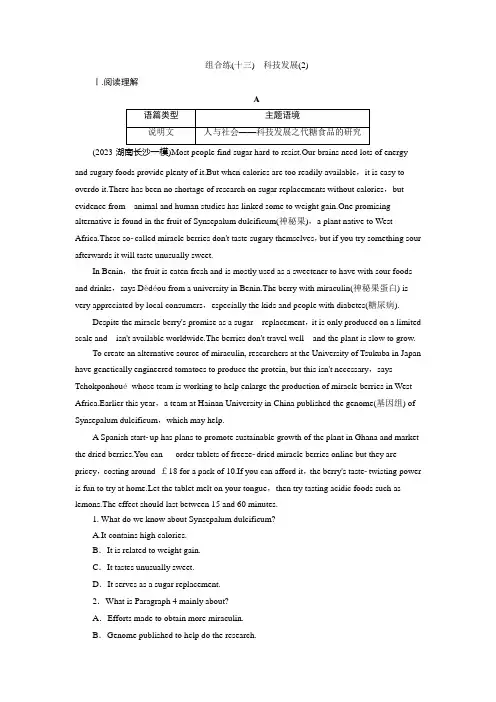
组合练(十三)科技发展(2)Ⅰ.阅读理解A(2023·湖南长沙一模)Most people find sugar hard to resist.Our brains need lots of energy and sugary foods provide plenty of it.But when calories are too readily available,it is easy to overdo it.There has been no shortage of research on sugar replacements without calories,but evidence from animal and human studies has linked some to weight gain.One promising alternative is found in the fruit of Synsepalum dulcificum(神秘果),a plant native to West Africa.These socalled miracle berries don't taste sugary themselves,but if you try something sour afterwards it will taste unusually sweet.In Benin,the fruit is eaten fresh and is mostly used as a sweetener to have with sour foods and drinks,says Dèdéou from a university in Benin.The berry with miraculin(神秘果蛋白) is very appreciated by local consumers,especially the kids and people with diabetes(糖尿病).Despite the miracle berry's promise as a sugar replacement,it is only produced on a limited scale and isn't available worldwide.The berries don't travel well and the plant is slow to grow.To create an alternative source of miraculin, researchers at the University of Tsukuba in Japan have genetically engineered tomatoes to produce the protein, but this isn't necessary,says Tchokponhouéwhose team is working to help enlarge the production of miracle berries in West Africa.Earlier this year,a team at Hainan University in China published the genome(基因组) of Synsepalum dulcificum,which may help.A Spanish startup has plans to promote sustainable growth of the plant in Ghana and market the dried berries.You can order tablets of freezedried miracle berries online but they are pricey,costing around £18 for a pack of 10.If you can afford it,the berry's tastetwisting power is fun to try at home.Let the tablet melt on your tongue,then try tasting acidic foods such as lemons.The effect should last between 15 and 60 minutes.1. What do we know about Synsepalum dulcificum?A.It contains high calories.B.It is related to weight gain.C.It tastes unusually sweet.D.It serves as a sugar replacement.2.What is Paragraph 4 mainly about?A.Efforts made to obtain more miraculin.B.Genome published to help do the research.C.Creation advocated to produce miracle berries.D.Transformations performed to engineer tomatoes.3.What can we say about tablets of freezedried miracle berries?A.They are sour.B.They are inexpensive.C.They are accessible.D.They are productive.4.What is the author's attitude to getting the sugar alternative?A.Doubtful. B.Optimistic.C.Defensive. D.Conservative.[语篇解读]糖是人体不可或缺的营养素,但多吃会导致体重增加。
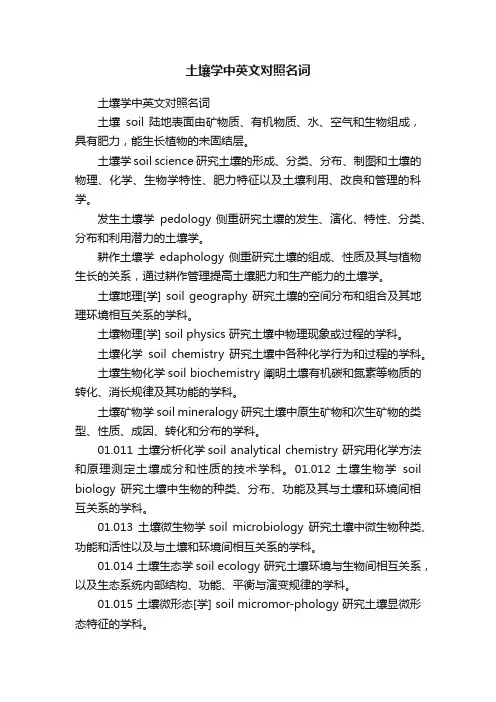
土壤学中英文对照名词土壤学中英文对照名词土壤soil 陆地表面由矿物质、有机物质、水、空气和生物组成,具有肥力,能生长植物的未固结层。
土壤学soil science 研究土壤的形成、分类、分布、制图和土壤的物理、化学、生物学特性、肥力特征以及土壤利用、改良和管理的科学。
发生土壤学pedology 侧重研究土壤的发生、演化、特性、分类、分布和利用潜力的土壤学。
耕作土壤学edaphology 侧重研究土壤的组成、性质及其与植物生长的关系,通过耕作管理提高土壤肥力和生产能力的土壤学。
土壤地理[学] soil geography 研究土壤的空间分布和组合及其地理环境相互关系的学科。
土壤物理[学] soil physics 研究土壤中物理现象或过程的学科。
土壤化学soil chemistry 研究土壤中各种化学行为和过程的学科。
土壤生物化学soil biochemistry 阐明土壤有机碳和氮素等物质的转化、消长规律及其功能的学科。
土壤矿物学soil mineralogy 研究土壤中原生矿物和次生矿物的类型、性质、成因、转化和分布的学科。
01.011 土壤分析化学soil analytical chemistry 研究用化学方法和原理测定土壤成分和性质的技术学科。
01.012 土壤生物学soil biology 研究土壤中生物的种类、分布、功能及其与土壤和环境间相互关系的学科。
01.013 土壤微生物学soil microbiology 研究土壤中微生物种类、功能和活性以及与土壤和环境间相互关系的学科。
01.014 土壤生态学soil ecology 研究土壤环境与生物间相互关系,以及生态系统内部结构、功能、平衡与演变规律的学科。
01.015 土壤微形态[学] soil micromor-phology 研究土壤显微形态特征的学科。
01.016 土壤资源soil resources 土壤类型的数量与质量。
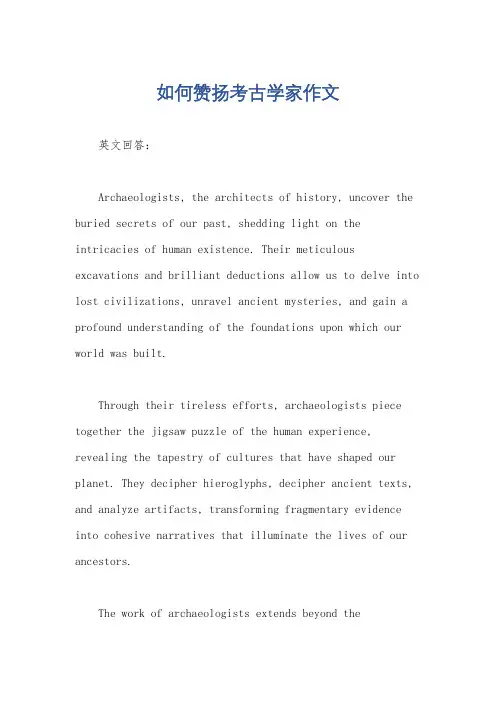
如何赞扬考古学家作文英文回答:Archaeologists, the architects of history, uncover the buried secrets of our past, shedding light on the intricacies of human existence. Their meticulous excavations and brilliant deductions allow us to delve into lost civilizations, unravel ancient mysteries, and gain a profound understanding of the foundations upon which our world was built.Through their tireless efforts, archaeologists piece together the jigsaw puzzle of the human experience, revealing the tapestry of cultures that have shaped our planet. They decipher hieroglyphs, decipher ancient texts, and analyze artifacts, transforming fragmentary evidence into cohesive narratives that illuminate the lives of our ancestors.The work of archaeologists extends beyond theboundaries of history; it touches upon anthropology, sociology, and even evolutionary biology. By studying the material remains of past societies, they provide invaluable insights into human social behavior, technological advancements, and cultural practices. Their discoveries contribute to our collective knowledge, fostering a deeper appreciation for the diversity and complexity of human history.Modern archaeology employs advanced scientific techniques, such as radiocarbon dating, DNA analysis, and remote sensing, to enhance its accuracy and precision. These tools enable archaeologists to peer deeper into the past, unearthing previously unknown settlements, reconstructing ancient environments, and identifying the origins of civilizations.The dedication and passion of archaeologists is truly remarkable. They spend countless hours in the field, enduring harsh weather conditions and grueling physical labor. Their unwavering commitment to the preservation of our heritage is an inspiration to all who value theimportance of knowledge and understanding.In recognition of their invaluable contributions to our understanding of the human story, we extend our heartfelt gratitude to archaeologists worldwide. Their tireless work enriches our lives, ignites our imaginations, and inspires us to connect with our ancestors and embrace the wonders of the past.中文回答:考古学家,历史的建筑师,揭开我们过去埋藏的秘密,阐明人类存在的错综复杂性。
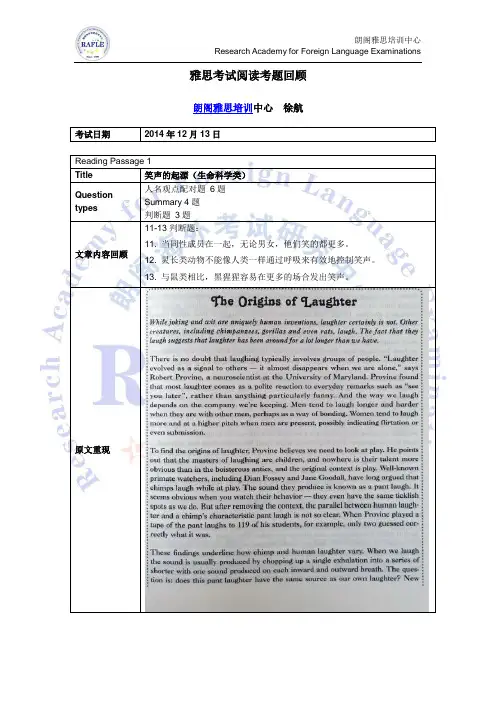
雅思考试阅读考题回顾朗阁雅思培训中心徐航考试日期2014年12月13日Reading Passage 1Title 笑声的起源(生命科学类)Question types 人名观点配对题6题Summary 4题判断题3题文章内容回顾11-13判断题:11. 当同性成员在一起,无论男女,他们笑的都更多。
12. 灵长类动物不能像人类一样通过呼吸来有效地控制笑声。
13. 与鼠类相比,黑猩猩容易在更多的场合发出笑声。
原文重现题型难度分析第一篇是经典机经旧文,版本号V100904。
难度一般,话题属于生命科学类文章,用动物和人做实验的特点考生也很熟悉。
只是一些单词需要课下认知,例如primate, chimpanzee等。
1-6人名观点配对:1. Babies and some animals produce laughter which sounds similar.选:B2. Primates are not the only animals who produce laughter. 选:D.3. Laughter can be used to show that we feel safe and secure with others. 选:A4. Most human laughter is not a response to a humorous situation. 选:C5. Animal laughter evolved before human laughter. 选:B6. Laughter is a social activity.List of PeopleA ProvineB ZimmermanC PankscppD Flamson7-10 Summary:Some scientists believe that laughter first developed out of 7. play. Research has revealed that human and chimp laughter may have the same 8. origins. Scientists have long been aware that 9. primates laugh, but it now appears that laughter might be more widespread than once thought. Although the reasons why humans started to laugh arc still unknown, it seems that laughter may result from the 10. confidence we feel with another person.A. combatB. chirpsC. pitchD. originsE. playF. ratsG. primatesH. confidenceI. fearJ. babiesK. tickling11-13判断题TRUE/FLASE/ NOT GIVEN:11. Both men and women laugh more when they arc with members of the same sex. NOT GIVEN12. Primates lack sufficient breath control to be able to produce laughs the way humans do. TRUE13. Chimpanzees produce laughter in a wider range of situations than rats do. NOT GIVEN题型技巧分析判断题:顺序题型,注意定位词和考点词,注意区分FALSE和NOT GIVEN 的辨析,FALSE是文章有提到信息并且与题目信息对立,NOT GIVEN是文章没提及题目所问信息,所以考点词的推测对区分FALSE和NOT GIVEN 有很大影响。
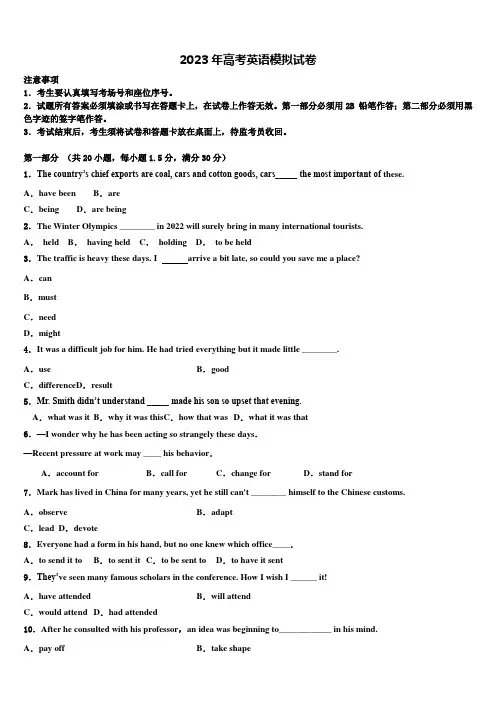
2023年高考英语模拟试卷注意事项1.考生要认真填写考场号和座位序号。
2.试题所有答案必须填涂或书写在答题卡上,在试卷上作答无效。
第一部分必须用2B 铅笔作答;第二部分必须用黑色字迹的签字笔作答。
3.考试结束后,考生须将试卷和答题卡放在桌面上,待监考员收回。
第一部分(共20小题,每小题1.5分,满分30分)1.The country’s chief exports are coal, cars and cotton goods, cars_____ the most important of these.A.have been B.areC.being D.are being2.The Winter Olympics ________ in 2022 will surely bring in many international tourists.A.held B.having held C.holding D.to be held3.The traffic is heavy these days. I arrive a bit late, so could you save me a place?A.canB.mustC.needD.might4.It was a difficult job for him. He had tried everything but it made little ________.A.use B.goodC.difference D.result5.Mr. Smith didn’t understand _____ made his son so upset that evening.A.what was it B.why it was this C.how that was D.what it was that6.—I wonder why he has been acting so strangely these days.—Recent pressure at work may ____ his behavior.A.account for B.call for C.change for D.stand for7.Mark has lived in China for many years, yet he still can't ________ himself to the Chinese customs.A.observe B.adaptC.lead D.devote8.Everyone had a form in his hand, but no one knew which office____.A.to send it to B.to sent it C.to be sent to D.to have it sent9.They’ve seen many famous scholars in the conference. How I wish I ______ it!A.have attended B.will attendC.would attend D.had attended10.After he consulted with his professor,an idea was beginning to____________ in his mind.A.pay off B.take shapeC.work out D.make up11.Reporters asked him to ______ his position on welfare reform.A.clarify B.divide C.instruct12.--- I have been working for more than 30 years! I’m going to retire next month.--- Really? You don’t look a day 40!A.over B.byC.with D.for13.Allen followed his customer across the yard and stood on the step of the house, two shopping bags.A.lifted B.having lifted C.to lift D.lifting14.It s a good idea to get students to retell a story their own words.A.of B.in C.by D.through15.Jack and Mike were found cheating in the exam, and_______by their teacher at the moment.A.were scolded B.are being scoldedC.have been scolded D.were being scolded16.After college, he was employed in a middle school and there ever since.A.would worked B.had workedC.worked D.has worked17.It is not surprising that she was elected ______ monitor ;she is ______ very smart girl who has the ability to organize the class well.A./; the B./; aC.a;a D.the;/18.One of the true tests of leadership is the ability to recognize a problem ________ it becomes an emergency. A.when B.beforeC.after D.unless19.Don’ t worry. A number of efforts are being made ______ the whole system operating normally.A.being kept B.keptC.keeping D.to keep20.Playing with their peers, children learn to and not do exactly what they want to do.A.compromise B.competeC.contribute D.construct第二部分阅读理解(满分40分)阅读下列短文,从每题所给的A、B、C、D四个选项中,选出最佳选项。
雅思(阅读)模拟试卷102(题后含答案及解析) 题型有:1. Reading ModuleReading Module (60 minutes)You should spend about 20 minutes on Questions 1-13, which are based on Reading Passage 1 below. Radiocarbon Dating The Profile of Nancy AthfieldHave you ever picked up a small stone off the ground and wondered how old it was? Chances are, that stone has been around many more years than your own lifetime. Many scientists share this curiosity about the age of inanimate objects like rocks, fossils and precious stones. Knowing how old an object is can provide valuable information about our prehistoric past. In most societies, human beings have kept track of history through writing. However, scientists are still curious about the world before writing, or even the world before humans. Studying the age of objects is our best way to piece together histories of our pre-historic past. One such method of finding the age of an object is called radiocarbon dating. This method can find the age of any object based on the kind of particles and atoms that are found inside of the object. Depending on what elements the object is composed of, radiocarbon can be a reliable way to find an object’s age. One famous specialist in this method is the researcher Nancy Athfield. Athfield studied the ancient remains found in the country of Cambodia. Many prehistoric remains were discovered by the local people of Cambodia. These objects were thought to belong to some of the original groups of humans that first came to the country of Cambodia. The remains had never been scientifically studied, so Nancy was greatly intrigued by the opportunity to use modern methods to discover the true age of these ancient objects.Athfield had this unique opportunity because her team, comprised of scientists and filmmakers, were in Cambodia working on a documentary. The team was trying to discover evidence to prove a controversial claim in history: that Cambodia was the resting place for the famous royal family of Angkor. At that time, written records and historic accounts conflicted on the true resting place. Many people across the world disagreed over where the final resting place was. For the first time, Athfield and her team had a chance to use radiocarbon dating to find new evidence. They had a chance to solve the historic mystery that many had been arguing over for years.Athfield and her team conducted radiocarbon dating of many of the ancient objects found in the historic site of Angkor Wat. Nancy found the history of Angkor went back to as early as 1620. According to historic records, the remains of the Angkor royal family were much younger than that, so this evidence cast a lot of doubt as to the status of the ancient remains. The research ultimately raised more questions. If the remains were not of the royal family, then whose remains were being kept in the ancient site? Athfield’s team left Cambodia with more questions unanswered. Since Athfield’s team studied the remains, new remains have been unearthed at the ancient site of Angkor Wat, so it is possible that these new remains could be the true remains of the royal family. Nancywished to come back to continue her research one day.In her early years, the career of Athfield was very unconventional. She didn’t start her career as a scientist. At the beginning, she would take any kind of job to pay her bills. Most of them were low-paying jobs or brief community service opportunities. She worked often but didn’t know what path she would ultimately take. But eventually, her friend suggested that Athfield invest in getting a degree. The friend recommended that Athfield attend a nearby university. Though doubtful of her own qualifications, she applied and was eventually accepted by the school. It was there that she met Willard Libby, the inventor of radiocarbon dating. She took his class and soon had the opportunity to complete hands-on research. She soon realised that science was her passion. After graduation, she quickly found a job in a research institution.After college, Athfield’s career in science blossomed. She eventually married, and her husband landed a job at the prestigious organisation GNN. Athfield joined her husband in the same organisation, and she became a lab manager in the institution. She earned her PhD in scientific research, and completed her studies on a kind of rat when it first appeared in New Zealand. There, she created original research and found many flaws in the methods being used in New Zealand laboratories. Her research showed that the subject’s diet led to the fault in the earlier research. She was seen as an expert by her peers in New Zealand, and her opinion and expertise were widely respected. She had come a long way from her old days of working odd jobs. It seemed that Athfield’s career was finally taking off.But Athfield’s interest in scientific laboratories wasn’t her only interest. She didn’t settle down in New Zealand. Instead, she expanded her areas of expertise. Athfield eventually joined the field of Anthropology, the study of human societies, and became a well-qualified archaeologist. It was during her blossoming career as an archaeologist that Athfield became involved with the famous Cambodia project. Even as the filmmakers ran out of funding and left Cambodia, Athfield continued to stay and continue her research.In 2003, the film was finished in uncertain conclusions, but Nancy continued her research on the ancient ruins of Angkor Wat. This research was not always easy. Her research was often delayed by lack of funding, and government paperwork. Despite her struggles, she committed to finishing her research. Finally, she made a breakthrough. Using radiocarbon dating, Athfield completed a database for the materials found in Cambodia. As a newcomer to Cambodia, she lacked a complete knowledge of Cambodian geology, which made this feat even more difficult. Through steady determination and ingenuity, Athfield finally completed the database. Though many did not believe she could finish, her research now remains an influential and tremendous contribution to geological sciences in Cambodia. In the future, radiocarbon dating continues to be a valuable research skill. Athfield will be remembered as one of the first to bring this scientific method to the study of the ancient ruins of Angkor Wat.Questions 1-7Do the following statements agree with the information given in Reading Passage 1? In boxes 1-7 on you answer sheet, writeTRUE if the statement agrees with the informationFALSE if the statement contradicts with the informationNOT GIVEN if there is no information on this.1.Nancy Athfield first discovered the ancient remains in Cambodia.A.TRUEB.FALSEC.NOT GIVEN正确答案:B解析:题干说:南希.阿什菲尔德是第一个发现柬埔寨历史遗迹的人。
用英语说中国夏朝根据自己的喜好,选着适合自己的一种英语学习方法,这样才会有利于学习英语。
小编在此献上用英语说中国历史的故事,希望大家喜欢。
用英语说中国夏朝:General 概况The first prehistoric dynasty is said to be Xia, from about the twenty-first to the sixteenth century B.C.第一个史前朝代应该是夏朝,从公元前21世纪至公元前16世纪。
Until scientific excavations were made at early bronze-age sites at Anyang, Henan Province, in 1928,在1928年对河南省安阳的青铜时代早期遗址进行系统挖掘以前,it was difficult to separate myth from reality in regard to the Xia.将关于夏朝的传说同现实区分开是困难的。
But since then, and especially in the 1960s and 1970s,但是从那时起,尤其是在20世纪60年代和70年代,archaeologists have uncovered urban sites, bronze implements, and tombs that point to the existence of Xia civilization in the same locations cited in ancient Chinese historical texts.考古学家们开掘出了位于与古代中国历史文章中提到的相同位置的城区、青铜器以及墓穴,而这些都表明了夏王朝的存在。
At minimum, the Xia period marked an evolutionary stage between the late Neolithic cultures and the typical Chinese urban civilization of the Shang dynasty.至少,夏朝标志着新石器文化末期与商朝典型的中国城市文明之间进化的阶段。
放射性碳法(radiocarbon dating)是同位素地质年龄测定方法之一。
自然界放射性同
位素14C主要是高空大气中的14 N在宇宙射线作用下形成的,同时又以半衰期为(5568±30)年[Godwin1962用(5730±40)年]的速度衰变为14N(β衰变);自然界14C的含量实际上处于动态平衡。
14 C与氧结合成CO2,通过大气的对流、生物的吸收以及溶解于水中的CO2与大气CO,不断进行同位素交换,使得14 C均匀地分布于大气圈、水圈和生物圈。
当生物死亡或溶于水中的CO2沉淀为碳酸盐之后,上述同位素交换过程即行终止。
此后,生物遗体及碳酸盐中的14C因衰变而减少。
生物死亡时间愈久,遗体中14C含量愈低。
通过测定埋藏在地下的生物遗体或碳酸盐中的14 C的放射性强度,并以现代同类生物中
14C的放射性强度作为原始强度,根据放射性衰变方程计算样品的年龄。
由于大气中放射
性碳含量随时间发生过系统的变化,年龄计算过程中有时需作一些修正。
放射性碳法能精确测出5万年以前的生物遗迹。
14C测年具有测量精度高,可测样品种类多和数据可靠等优点。
放射性碳法适用于考古学和第四纪地质研究。
常用样品为木炭、泥炭、木材、贝壳、骨骼、纸张、皮革、衣服以及某些沉积碳酸盐等。